China Railway High-speed
 | |
| Locale |
|
|---|---|
| Dates of operation | 2007–present |
| Track gauge | 1,435 mm (4 ft 8 1⁄2 in) Standard gauge |
| Headquarters | Beijing, China |
| China Railway High-speed | |||||||
| Simplified Chinese | 中国高速铁路 | ||||||
|---|---|---|---|---|---|---|---|
| Traditional Chinese | 中國高速鐵路 | ||||||
| |||||||
China Railway High-speed (CRH) is the high-speed rail service operated by China Railway. Hexie Hao (simplified Chinese: 和谐号; traditional Chinese: 和諧號; pinyin: Héxié Hào; literally: "Harmony") is the designation for rolling stock operated for this service. All trains had been marked "CRH", before being changed shortly afterwards to the Chinese characters "和谐号" on the centre of the head vehicles and the side of the walls of other vehicles. The introduction of CRH was a major part of the sixth national railway speedup, implemented on April 18, 2007. All high-speed trains in commercial use in China are named CRH .[1] CRH1/2A/2B/2E/5 are expected to have a maximum speed of 250 km/h (160 mph), and CRH2C/3 have a maximum speed of 350 km/h (220 mph). The new trainsets CRH380A have a maximum test speed of 416.6 km/h (258.9 mph). The fastest trainset, CRH380BL, attained a maximum test speed of 487.3 km/h 302.8 mph).
High-speed rail network
High-speed rail services were first introduced in 2007 operating with CRH rolling stock. Those run on existing lines that have been upgraded to speeds of up to 250 km/h (160 mph) and on newer dedicated high-speed track rated up to 350 km/h (220 mph).
CRH Rolling stock
China Railway High-speed runs different electric multiple unit trainsets, the designs for which are imported from other nations and designated CRH-1 through CRH-5 and CRH380A(L), CRH380B(L), and CRH380C(L). CRH trainsets are intended to provide fast and convenient travel between cities. Some of the trainsets are manufactured locally through technology transfer, a key requirement for China. The signalling, track and support structures, control software, and station design are developed domestically with foreign elements as well, so the system as a whole is predominantly Chinese.[2] China currently holds many new patents related to the internal components of these trains, re-designed in China to allow the trains to run at higher speeds than the foreign designs allowed. However, these patents are only valid within China, and as such hold no international power.[2][3][4][5]
The trainsets are as follows:
- CRH1 produced by Bombardier Transportation's joint venture Sifang Power (Qingdao) Transportation (BST), CRH1A, and CRH1B, nicknamed "Metro" or "Bread", derived from Bombardier's Regina; CRH1E, nicknamed "Lizard", is Bombardier's ZEFIRO 250 design
- CRH1A: sets consists of 8 cars; maximum operating speed of 250 km/h
- CRH1B: a modified 16-car version; maximum operating speed of 250 km/h
- CRH1E: a 16-car high-speed sleeper version; maximum operating speed of 250 km/h
- CRH2: nicknamed "Hairtail", derived from E2 Series 1000 Shinkansen
- CRH2A: In 2006, China unveiled CRH2, a modified version of the Japanese Shinkansen E2-1000 series. An order for 60 8-car sets had been placed in 2004, with the first few built in Japan, the rest produced by Sifang Locomotive and Rolling Stock in China.[6]
- CRH2B: a modified 16-car version of CRH2; maximum operating speed of 250 km/h
- CRH2C (Stage one): a modified version of CRH2 with a maximum operating speed up to 300 km/h as a result of replacing two intermediate trailer cars with motored cars
- CRH2C (Stage two): a modified version of CRH2C (stage one) has a maximum operating speed up to 350 km/h by using more powerful motors
- CRH2E: a modified 16-car version of CRH2 with sleeping cars
- CRH3: nickname "Rabbit", derived from Siemens ICE3 (class 403); 8-car sets; maximum operating speed of 350 km/h
- CRH5A: derived from Alstom Pendolino ETR600; 8-car sets; maximum operating speed of 250 km/h[7]
- CRH6: designed by CSR Puzhen and CSR Sifang, will be manufactured by CSR Jiangmen. It is designed to have two versions: one with a top operating speed of 220 km/h; the other with a top operating speed of 160 km/h. They will be used on 200 km/h or 250 km/h Inter-city High Speed Rail lines; planned to enter service by 2011
- CRH380A; Maximum operating speed of 380 km/h. Developed by CSR and manufactured by Sifang Locomotive and Rolling Stock; entered service in 2010
- CRH380B: upgraded version of CRH3; maximum operating speed of 380 km/h, manufactured by Tangshan Railway Vehicle and Changchun Railway Vehicles; entered service in 2011
- CRH380CL: designed and manufactured by Changchun Railway Vehicles. Maximum operating speed of 380 km/h; planned to enter service in 2012
- CRH380D: also named Zefiro 380; maximum operating speed of 380 km/h, manufactured by Bombardier Sifang (Qingdao) Transportation Ltd.; planned to enter service in 2012
CRH1A, B,E, CRH2A, B,E, and CRH5A are designed for a maximum operating speed (MOR) of 200 km/h and can reach up to 250 km/h. CRH3C and CRH2C designs have an MOR of 300 km/h, and can reach up to 350 km/h, with a top testing speed more than 380 km/h. However, in practical terms, issues such as maintenance costs, comfort, and safety make the maximum speed of more than 380 km/h impractical and remain limiting factors.
| Equipment type | Top speed in test | Designed speed | Seating capacity | Formation | Power (under 25 kV) |
Enter Service |
|---|---|---|---|---|---|---|
| CRH1A | 278 km/h (173 mph) | 250 | 668 or 611 or 645 | 5M3T | 5,300 kW | 2007 |
| CRH1B | 292 km/h (181 mph) | 250 | 1299 | 10M6T | 11,000 kW | 2009 |
| CRH1E | 250 | 618 or 642 | 10M6T | 11,000 kW | 2009 | |
| CRH2A | 282 km/h (175 mph) | 250 | 610 or 588 | 4M4T | 4,800 kW | 2007 |
| CRH2B | 275 km/h (171 mph) | 250 | 1230 | 8M8T | 9,600 kW | 2008 |
| CRH2C Stage 1 | 394.2 km/h (244.9 mph) | 300 | 610 | 6M2T | 7,200 kW | 2008 |
| CRH2C Stage 2 | 350 | 610 | 6M2T | 8,760 kW | 2010 | |
| CRH2E | 250 | 630 | 8M8T | 9,600 kW | 2008 | |
| CRH3C | 394.3 km/h (245.0 mph) | 350 | 600 or 556 | 4M4T | 8,800 kW | 2008 |
| CRH5A | 250 | 622 or 586 or 570 | 5M3T | 5,500 kW | 2007 | |
| CRH380A | 416.6 km/h (258.9 mph) | 380 | 494 | 6M2T | 9,600 kW | 2010 |
| CRH380AL | 486.1 km/h (302.0 mph) | 380 | 1027 | 14M2T | 20,440 kW | 2010 |
| CRH380B | 380 | unknown | 4M4T | 9,200 kW | 2011 | |
| CRH380BL | 487.3 km/h (302.8 mph) | 380 | 1004 | 8M8T | 18,400 kW | 2010 |
| CRH380CL | 380 | 8M8T | 19,200 kW | 2012 | ||
| CRH380D | 380 | 495 | 4M4T | 10,000 kW | 2012 | |
| CRH380DL | 380 | 1013 | 8M8T | 20,000 kW | Canceled (2012 original plan) | |
| CRH6 | 220 | 586 | 4M4T | unknown | 2011 |
Chinese MOR CRH trainsets order timetable
Chinese MOR CRH trainsets order timetable
| Date | Factory | Speed Level | Type | Quantity (set) |
Quantity (car) |
Amount |
|---|---|---|---|---|---|---|
| 2004-10-10[8] | Alstom | 250 km/h | CRH5A | 3 | 24 | 620 million EUR |
| CNR Changchun | 57 | 456 | ||||
| 2004-10-12[9] | BST (Bombardier & CSR) | 250 km/h | CRH1A | 20 | 160 | US$350 million |
| 2004-10-20[10] | Kawasaki | 250 km/h | CRH2A | 3 | 24 | 9,300 million RMB |
| CSR Sifang | 57 | 456 | ||||
| 2005-05-30[11] | BST | 250 km/h | CRH1A | 20 | 160 | US$350 million |
| 2005-06[10] | CSR Sifang | 300 km/h | CRH2C Stage one | 30 | 240 | 8,200 million RMB |
| 350 km/h | CRH2C Stage two | 30 | 240 | |||
| 2005-11-20[12] | Siemens | 350 km/h | CRH3C | 3 | 24 | 13,000 million RMB |
| CNR Tangshan | 57 | 456 | ||||
| 2007-10-31[13] | BST | 250 km/h | CRH1B | 20 | 320 | 1,000 million EUR |
| CRH1E | 20 | 320 | ||||
| 2007-11[14] | CSR Sifang | 250 km/h | CRH2B | 10 | 160 | 1,200 million RMB |
| 2007-11[10] | CSR Sifang | 250 km/h | CRH2E | 6 | 96 | 900 million RMB |
| 2008-12-06[10] | CSR Sifang | 250 km/h | CRH2E | 14 | 224 | 2,100 million RMB |
| 2009-09-23[15] | CNR Changchun | 250 km/h | CRH5A | 30 | 240 | 4,800 million RMB |
| 2009-03-16[16] | CNR Tangshan | 380 km/h | CRH380BL | 70 | 1,120 | 39,200 million RMB |
| CNR Changchun | 30 | 480 | ||||
| 2009-09-28[17] | CSR Sifang | 380 km/h | CRH380A | 40 | 320 | 45,000 million RMB |
| CRH380AL | 100 | 1,600 | ||||
| 2009-09-28[17] Modified 2012-09-05[18] |
BST | 380 km/h | CRH380D | 70 | 560 | 27,400 million RMB |
| 250 km/h | CRH1A | 46 | 368 | |||
| 250 km/h | Zefiro 250NG | 60 | 480 | |||
| 2009-09-28[19] | CNR Changchun | 380 km/h | CRH380B | 40 | 320 | 23,520 million RMB |
| CRH380BL | 15 | 240 | ||||
| CRH380CL | 25 | 400 | ||||
| 2009-09-28[20] | CNR Tangshan | 350 km/h | CRH3C[21] | 20 | 160 | 3,920 million RMB |
| 2009-12-30[22] | CSR Puzhen | 220 km/h | CRH6 | 24 | 192 | 2,346 million RMB |
| 2010-07-16[23] | BST | 250 km/h | CRH1A | 40 | 320 | 5,200 million RMB |
| 2010-09-14[24] | CSR Sifang | 250 km/h | CRH2A | 40 | 320 | 3,400 million RMB |
| 2010-10-13[25] | CNR Changchun | 250 km/h | CRH5A | 20 | 160 | 2,700 million RMB |
| 2011-04-26 | CNR Changchun | 250 km/h | CRH5A | 30 | 240 | 3,870 million RMB |
| Total | 1050 | 10,240 |
Chinese CRH trainsets delivery timetable
Based on data published by Sinolink Securities;[26][27] some small changes were made according to the most recent news.
| Type | 2006 | 2007 | 2008 | 2009 |
2010 |
2011 |
Future (plan) |
Total |
| CRH1A | 8 | 18 | 12 | 2 | 20 | 20 | 106 | 80 |
| CRH2A | 19 | 41 | 15 | 25 | 100 | |||
| CRH5A | 27 | 29 | 4 | 30 | 20 | 30 | 140 | |
| CRH1B | 4 | 9 | 7 | 20 | ||||
| CRH1E | 3 | 8 | 9 | 20 | ||||
| CRH2B | 10 | 10 | ||||||
| CRH2E | 6 | 14 | 20 | |||||
| CRH2C | 10 | 20 | 30 | 60 | ||||
| CRH3C | 7 | 36 | 37 | 80 | ||||
| CRH380A | 40 | 40 | ||||||
| CRH380AL | 6 | 94 | 100 | |||||
| CRH380B | 20 | 201 | 40 | |||||
| CRH380BL | 11 | 49 | 551 | 115 | ||||
| CRH380CL | 251 | 25 | ||||||
| CRH380D | 702 | 70 | ||||||
| CRH380DL | 02 | 0 | ||||||
| CRH6 | 24 | 24 | ||||||
| Total | 27 | 86 | 78 | 88 | 204 | 237 | 330 | 1050 |
| Cumulative | 27 | 113 | 191 | 279 | 483 | 744 | 1050 | 1050 |
- ^1 All CRH380B and CRH380C units to be delivered before 2012.
- ^2 All CRH380D units to be delivered before 2014.
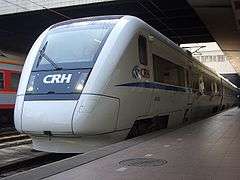
- Two coupled 8-car CRH1A electric multiple unit train sets in Nanchang
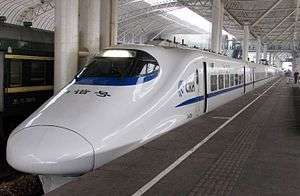
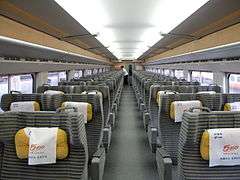 CRH2 First Class Coach
CRH2 First Class Coach- CRH2 Second Class Coach
 China CRH2C locomotives at Shanghai Hongqiao Station
China CRH2C locomotives at Shanghai Hongqiao Station
- First-class cabin inside Beijing-Tianjin Intercity CRH3 train
 CRH2C and CRH3C at Tianjin Railway Station
CRH2C and CRH3C at Tianjin Railway Station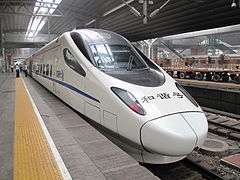
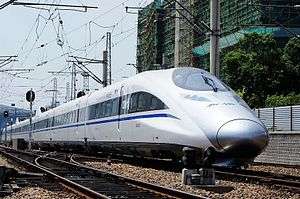
- CRH380BL Business Coach
.jpg) CRH380CL at Beijing South Railway Station
CRH380CL at Beijing South Railway Station.jpg) CRH380D at Beijing South Railway Station
CRH380D at Beijing South Railway Station
Technology development
Before the introduction of foreign technology, China conducted independent attempts to domestically develop high-speed rail technology. Some notable results included the China Star, but domestic Chinese companies lacked the technology and expertise of foreign companies, and the research process consumed a large amount of time. People's Republic of China Ministry of Railways spokesman Zhang Shuguang stated that due to historical reasons, China's overall railway technology and equipment is similar to that of developed countries' rail systems in the 1970s; high-speed rolling stock development is still in its infancy stage. If using only their own resources and expertise, the country might need a decade or longer to catch up with developed nations.[28] In 2004, the Chinese State Council and the Ministry of Railways defined a modern railway technology and equipment policy as "the introduction of advanced technology, the joint design and production, to build China brand". The realization of the railway "leapfrog development" is the key task required to develop and utilize the technology required for high-speed trains (higher than 200 km per hour).
Technology introduction
On April 9, 2004, the Chinese government held a conference on modern railway equipment and rolling stock, in which they drafted the current Chinese plan to modernize the country's railway infrastructure with advanced technologies.
On June 17, 2004, the Ministry of Railways launched the first round of bidding on the high-speed rail technology, but the company must be:
- legally registered in the PRC, with rail EMU manufacturing capacity
- able to manufacture trains with the ability to reach 200 km/h
High-speed EMU design and manufacturing technology companies, including Siemens, Alstom, Kawasaki Heavy Industries and Bombardier, initially had hoped to enter into a joint venture in China, but was rejected by the Ministry of Railways. The MOR set these guidelines for joint ventures to be acceptable:
- comprehensive transfer of key technologies
- lowest price in the world
- use of a Chinese brand
A comprehensive transfer of technology to Chinese enterprises (especially in systems integration, AC drive and other core technologies) was necessary to allow domestic enterprises to master the core technology. While foreign partners might provide technical services and training, the Chinese companies must ultimately be able to function without the partnership.[29] Railway equipment manufacturers in China were free to choose foreign partners, but foreign firms must pre-bid and sign the technology transfer agreement with China's domestic manufacturers, so the Chinese rolling stock manufacturers could comprehensively and systematically learn advanced foreign technology.[30]
In the first round of bidding, 140 rolling stock orders were divided into seven packages of twenty orders each. After extensive review and negotiation, three consortiums won the bid:
- Changchun Railway Vehicles Co., Ltd. (owned by CNR) with France's Alstom
- Sifang Locomotive (owned by CSR) with Japan's Kawasaki Heavy Industries
- Sifang Locomotive (owned by CSR) with Canada's Bombardier
These three consortiums were each given three, three, and one twenty order packages respectively.[30] Germany's Siemens, as a result of an expensive technology bid — the prototype vehicle cost was 350 million yuan each column, technology transfer fee 390 million euros — did not get any orders in the first round.[31][32] EMU tendered 22.7 billion yuan for technology transfer payments in the first payment, accounting for 51 per cent of the amount of the tender.
In November 2005, the Chinese Ministry of Railways and Siemens reached an agreement, and Siemens in a joint venture with Changchun Railway Vehicles and Tangshan Railway Vehicle (both owned by CNR) was awarded sixty 300 km/h high-speed train orders.
Innovation
The introduction of high-speed trains, a foreign advanced technology, was required in order to implement China's "Long-term Scientific and Technological Development (2006–2020)". The core technology innovations necessary for a high-speed rail system to meet the needs of China's railway development resulted in the Ministry of Science and Ministry of Railways signing the "independent innovation of Chinese high-speed train cooperation agreement Joint Action Plan" on February 26, 2008.[33] Academicians and researchers from CAS, Tsinghua University, Zhejiang University, Southwest Jiaotong University, and Beijing Jiaotong University have committed to working together on basic research into improving China's scientific and industrial resources into developing a high-speed train system.
Under the agreement, China's joint action plan for improvement of train service and infrastructure has four components:[34]
- Develop key technologies to create a network capable of supporting trains' speeds of 350 km/hr and higher
- Establish intellectual property rights and international competitiveness
- Ministry of Science and the Ministry of Railways will work together to enhance industry research alliances, and innovation capability
- Promote China-related material and equipment capacity
The Chinese Ministry of Science has invested nearly 10 billion yuan in this science and technology plan, which is by far the largest investment program. The project has brought together a total of 25 universities, 11 research institutes, and national laboratories, and 51 engineering research centers. The Ministry of Science hopes to develop basic research sufficient to produce key technologies necessary to develop trains capable of 500 km per hour through the "863 Project" and "973 Project".[35]
Technology export
On 2009-07-27, Chinese Ministry deputy chief engineer Zhang Shuguang stated that America, India, Saudi Arabia and Brazil are interested in Chinese high-speed railway technology. July 28. The Federal Railroad Administration and the US government are negotiating on the introduction of Chinese railway technology[36]。 On 14 October 2009, Prime minister of Russia Vladimir Putin and the Russian Railroad Administration signed an Organizing and developing railway in Russia memo with Ministry of Railways of China, planning to build a high-speed railway from Vladivostok to Khabarovsk.[37]
Accident
On 23 July 2011 at approximately 20:00 CST, two high-speed trains travelling on the Yongtaiwen railway line No. D301 and No. D3115 bound for Fuzhou collided on a viaduct near Wenzhou, Zhejiang, leading to 40 deaths and 191 injuries. Both trains were on the same rail track, headed in the same direction. D3115 ground to a halt in front of D301 due to a loss of electric power caused by lightning striking a viaduct near the Ou River. Signalling systems purportedly failed, and D301 rear-ended the first train, sending four carriages off the viaduct.[38][39]
See also
References
- ↑ 国产高铁列车中华之星夭折记:部长更迭改变命运 (in Chinese). people.com.cn. 2011-08-09. Retrieved 2014-06-29.
- 1 2 Shirouzu, Norihiko (2010-11-17). "Train Makers Rail Against China's High-Speed Designs". The Wall Street Journal. Retrieved 2012-12-26.
- ↑ Wines, Michael; Bradsher, Keith (2011-02-17). "China Rail Chief's Firing Hints at Trouble". The New York Times. Retrieved 2012-12-27.
Many multinational companies also resent China for tweaking foreign designs and building the equipment itself rather than importing it.
- ↑ Johnson, Ian (2011-06-13). "High-Speed Trains in China to Run Slower, Ministry Says". The New York Times. Retrieved 2012-12-27.
In the past few months, some foreign companies that sold China its high-speed technology said the trains were not designed to operate at 215 miles per hour. The ministry said that Chinese engineers had improved on the foreign technology and that the trains were safe at the higher speeds.
- ↑ Xin, Dingding (2011-06-28). "Full steam ahead for high-speed rail patents overseas". China Daily. Retrieved 2012-12-27.
- ↑ "High speed trainsets take shape". Railway Gazette International. 2005-08-01.
- ↑ "China's high speed fleet expands steadily". Railway Gazette International. 2007-08-01.
- ↑ 法中企业握手互利共赢. news.xinhuanet.com (in Chinese). 2004-10-25.
- ↑ "2004年10月12日,BSP与铁道部及广州铁路(集团)签订了20列(160辆)EMU动车组". www.bsp.cn (in Chinese). 2006-01-12.
- 1 2 3 4 "CRH2型动车组详细资料及分类". news.chineserailways.com (in Chinese). 2009-12-14.
- ↑ 庞巴迪:又获铁道部动车组大订单. info.traffic.hc360.com (in Chinese). 2005-06-10.
- ↑ 西门子专家进驻唐山机车车辆厂. hebei.moform.gov.cn (in Chinese). 2006-08-15.
- ↑ "BSP公司在北京签订40列EMU动车组订单". www.bsp.cn (in Chinese). 2007-11-02.
- ↑ 招商证券-中国南车-601766-动车交付高峰来临,业绩逐季增... www.docin.com (in Chinese).
- ↑ "公司与北京铁路局签订了30列CRH5型动车组采购合同". www.cccar.com.cnom (in Chinese).
- ↑ 唐车公司拿到京沪高铁动车组大订单 总金额392亿. info.china.alibaba.com (in Chinese). 2009-03-17.
- 1 2 中国南车:中标巨额合同 增厚公司业绩. www.guosen.com.cn (in Chinese). 2009-09-30.
- ↑ http://www.railwaygazette.com/news/passenger/single-view/view/zefiro-250ng-included-in-revised-high-speed-train-contract.html
- ↑ 长客签下235亿订单. jlrbszb.chinajilin.com.cn (in Chinese). 2009-09-28.
- ↑ 招商证券-中国北车-601299-动车组第三批高毛利率订单将陆续交付. www.docin.com (in Chinese).
- ↑ "关于CRH3和380B的提问". bbs.ourail.com (in Chinese).
- ↑ 中国南车获国内首个城际列车项目订单 总值23.46亿人民币 (in Chinese).
- ↑ "Bombardier Sifang Awarded Fourth Contract for 40 Additional CRH1 High-Speed Trains in China". cn.bombardier.com. 2010-07-16.
- ↑ 中国南车:再中标动车组订单、未来高增长确定::全景证券频道. www.p5w.net (in Chinese). 2010-09-30.
- ↑ "http://news.xinmin.cn/rollnews/2010/10/13/7194620.html". news.xinmin.cn (in Chinese). 2010-10-13. External link in
|title=(help) - ↑ 中国南车研究报告:国金证券-中国南车-601766-通往春天的铁路设备龙头. docin.com (in Chinese).
- ↑ 国金证券-中国北车-601299-动车交付单价已触底,毛利率回升可期. docin.com (in Chinese).
- ↑ "Zhang Shuguang: railway technical equipment of modern achievement has been to benefit the masses". Chinese Government Network. 2007-04-29. Retrieved 2010-05-28.
- ↑ "China's "insist" Core Technology High Speed Rail: 6 years ago, finally got the reward persistence". Oriental Morning Post. 2010-03-18. Retrieved 2010-09-09.
- 1 2 "sixth speed railway will be 200 kilometers per hour of the introduction of locomotives". Xinhua. 2004-09-04. Retrieved 2010-09-20.
- ↑ Zhang Chunli (2008-09-02). "China's road to the introduction of High Speed Rail: 1.5 billion foreigners cut off overnight – Deputy Ministry of Railways engineer Zhang Shuguang Group of Chinese High Speed road of independent innovation". People's. Retrieved 2010-05-28.
- ↑ "China's high-speed railway construction generous: print media, technology absorption of the four countries envy". Xinhua. 2008-02-04. Retrieved 2010-05-28.
- ↑ "Science and Technology, Ministry of Railways jointly signed the "China's high-speed train innovation partnership joint action plan "". Science and Technology Portal. 2008-02-27. Retrieved 2010-05-28.
- ↑ "Ministry of Railways, Ministry of Science and the United deepened over 350 km per hour high speed train innovation". China Railway. 2008-02-29. Retrieved 2010-05-28.
- ↑ "High Speed Rail promote high-tech industries in China great development". "Science and Technology Daily". 2010-09-06. Retrieved 2010-09-28.
- ↑ "Media report America may import our rail way technology". Sina net. 2009-07-30. Retrieved 2010-05-28.
- ↑ "China will help Russia build railways". Phoenix net. 2009-19-14. Retrieved 2010-07-11. Check date values in:
|date=(help) - ↑ Krishnan, Ananth (July 24, 2011). "China bullet train collision triggers safety debate". The Hindu. Chennai, India.
- ↑ http://news.xinhuanet.com/english2010/china/2011-07/24/c_131004951.htm
- Shanghai-Beijing route to test bullet train. China Daily. January 16, 2007.
External links
| Wikimedia Commons has media related to China Railway High-speed. |